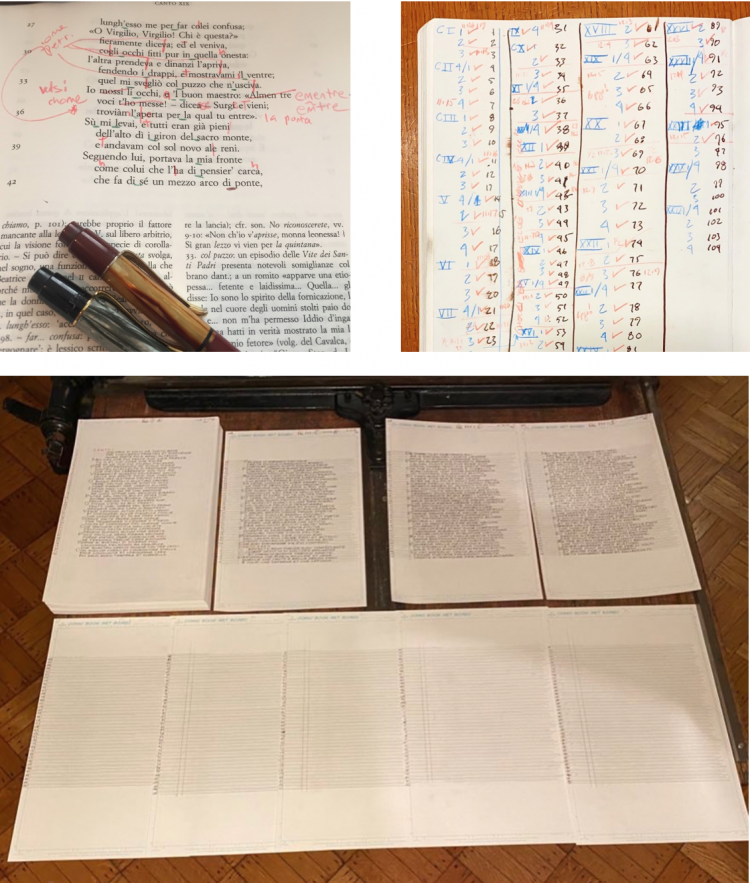The way Dante’s work first appeared was in manuscripts, so handwriting is a part of the way that his poem had first appeared.

350,000 Characters Later…
It’s no secret that contemporary artists wear many hats, and face many challenges. In the case of George Cochrane and his monumental project to create a new Divine Comedy manuscript, hand-writing all 350,000 characters, all three canticles, 14,233 verses of Dante’s masterpiece, was no small feat.
Interested in the whole story of how “La Divina Commedia – The New Manuscript” came to be? Check the index of articles here.

Inventing a New Font
But it wasn’t just the amount of characters George had to copy by hand over 6 long years that was a challenge, it was also the challenge of creating a new font and writing every single character in it! This meant committing to constant refinement, daily revisions, and a high attention to detail.

Cochrane, who comes from the tradition of comics, in fact approached the Comedy starting from the text, studying its language and even going back to the characteristic handwriting of the fourteenth-century illuminated manuscripts.
Simone Casini, Professor and Researcher of Humanities, University of Perugia
Just like a medieval monk, George has kept to a rigid schedule, waking before dawn to scribe his manuscript pages. Each page took him about 1.5 hours to complete. He would write, every single day for months, as many lines as he could complete before going to work.
Once pencil marks were complete, each character was scribed over with Sennilier India Ink containing shellac. Hours or days later once the ink was dry, George had to erase each and every pencil mark and fix every single error, sometimes opting to re-do an entire page if necessary. George copied the entire poem while his normal life was going on. The only free time in his daily schedule was often reserved for sleeping!

Reproducing George’s Hand Written Text
But how does a publisher achieve a faithful reproduction of a hand written type design that is only written in one language, Italian in this case, and use the same design for an English printing?
Facsimile Finder chose to work closely with Alessio D’Ellena, Type Designer and Graphic Designer, working in Milan as a professor and lecturer on Type Design, Lettering and Typography at Bauer Milan, EID Turin, and Naba Milan. Alessio was intrigued by the opportunity to work on reproducing the variety and richness of a personal writing system. As an Italian, Alessio was also excited to play a role in such a challenging work that divulges a text so important to Italian culture.

From a designer point of view, it’s almost impossible to reproduce one’s unique handwritten style and its variety in a typographical character. When we write by hand, each sign is unique; it’s an ultimate gesture, and its digital reproduction in a typeface is only similar. Moreover, hand writing is influenced by many things: speediness, dimensions of the surface, tools, glyphs and ligatures…
Alessio D’Ellena, Type Designer
Approaching handwritten text can be quite a challenge, even for a Type Designer. Alessio’s first goal was to decipher George’s handwritten signs and to understand how each one differs from another.
He then samples an appropriate number of signs, and then calls them back in rotation so the final effect is as close as possible to the handwritten text.

“The way Dante’s work first appeared was in manuscripts, so handwriting is a part of the way that his poem had first appeared.” George Cochrane
George sees Dante’s work as inseparable from the handwritten letter, placing importance on the original form that its first readers would have experienced it in. This connection was so strong that George felt a need to commit to handwriting the entire poem.
For readers of George’s Divine Comedy, once published, the goal is that it will transport them to the time of Dante, not just through the artistic expression inspired by hundreds of years of art, but also through the written word found on every page.
An Original Synthesis,
Ancient & Modern

Cochrane attempted an original synthesis, which was meant to be both ancient and modern, full of echoes of tradition and at the same time [very] highly personal. Thus, we can read Dante’s journey transcribed word by word, with philological attention, by a contemporary New York amanuensis. And above all we can “see” Dante’s “vision” through images of great efficacy, vigorous, and often amusing, which express our sensibility as people of the 21st century.
Simone Casini, Professor and Researcher of Humanities, University of Perugia
The chance to experience George’s vision of a new Divine Comedy is close at hand.
But without modern day patrons like you, this work of a lifetime will remain unpublished.
Stay tuned as we prepare for the launch of our upcoming Kickstarter, so that you, too, can experience the Divine Comedy through Dante’s eyes!

Don’t Miss Out!
Interested in the whole story of how “La Divina Commedia – The New Manuscript” came to be?
1. George Meets Dante: The Love Story & The Passion Project
2. A Monk in New York: A Journey Back in Time
3. On The Shoulders of Giants: One Man + 700 Years of Art Inspired by Dante
4. The Commedia & Comics: George Considers the Connections
5. The Artist as Scribe: 350.000 Characters Later… (you are here)
6. Illustrating the Commedia: Dante’s Color Library
7. Exclusive Book Design Preview: Handcrafted in Italy & Thoughtfully Designed by Giulia Fogliani

